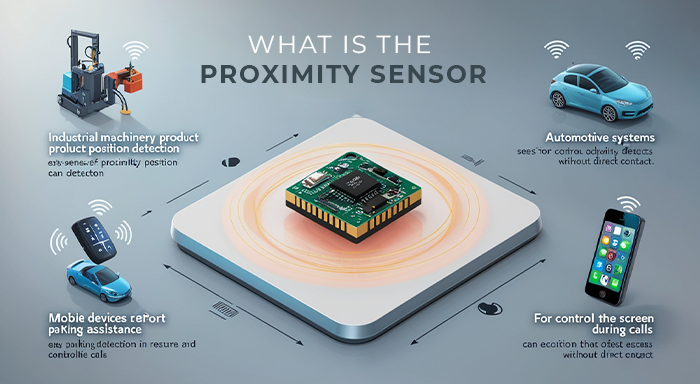
A proximity sensor refers to the device that detects the presence or movement of the objects within a specific range without any physical contact. By sensing the nearby objects, proximity sensors provides input to systems and devices that rely on accurate spatial awareness. From smartphones to the industrial automation, proximity sensors are used across various industries for their versatility, precision, and reliability.
How Do Proximity Sensors Work?
Proximity sensors work by release the electromagnetic fields or beams of radiation, such as infrared or ultrasonic waves. These waves further detect to the objects in close range. When an object enters the sensor’s detection area, it disrupts the field or reflects the radiation back to the sensor and a response get triggerd in the system.
Then the sensor communicate with the device to perform an action or send an alert depending on the specific application. This is how the proximity sensors work.
Common Types of Proximity Sensors
Let’s have a look at the common kinds of proximity sensors:-
1. (IR) Infrared Sensors:
Infrared sensor use infrared light to detect the objects and are a very common sensor in devices like TV remotes and automatic doors.
2. Ultrasonic Sensors:
Ultrasonic sensor release the sound waves to detect the objects that often used in parking sensors and industrial robotics.
3. Capacitive Sensors:
Capacitive Sensors detect the change in the electric field and are commonly used in touchscreen technology.
4. Inductive Sensors:
Inductive Sensors use electromagnetic fields to detect the metallic objects and are frequently applied in manufacturing.
Applications of Proximity Sensors
Proximity sensors have a wide range of applications in different industries. So, let’s a look at all of them.
1. Smartphones and Tablets
In mobile devices, proximity sensors are used to disabling the screen while talking of the mobile phone or performing the call to prevent the accidental touches. Therefore, it detect proximity or closeness of the ear and phone during a call.
2. Automotive Industry
Proximity sensors are used in cars use to enhance the safety by detecting the nearby obstacles during parking or lane changes. Backup sensors, for example, emit sound alerts when objects does get close to the vehicle.
3. Home Automation
Proximity sensors are used in smart home systems for performing the automated lighting process. It turn the lights on or off when movement is detected to save energy and add convenience.
4. Industrial Automation
In manufacturing, proximity sensors areused to detect the presence or absence of objects on assembly lines. It helps in streamlining the production and improve the safety by shutting down machines if someone gets too close of them.
5. Security Systems
Proximity sensors are the key in alarm systems as they detect the unauthorized movement near entry points like doors and windows. Proximity sensors are helpful in securing the homes and businesses by alerting owners to potential intruders.
6. Medical Equipment
Proximity sensors are also used in medical devices to track the equipment positioning and then help in ensuring the safety of patients and staff. For example, they detect the presence of objects in MRI rooms where magnetic interference can be dangerous.
Final Thoughts
Proximity sensors are the integral part of the today’s modern technology that offer the solutions for safety, efficiency, and convenience across multiple industries. Their versatility makes them an essential component in everything from smartphones to industrial equipment that reflect their importance in a connected and automated world.
Related Posts:
What is communication protocol and its importance in IoT?
IoT Sensors : Growing Impact in Modern Technology
Level Sensors | Types, Applications, and Key Features